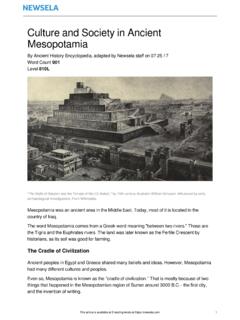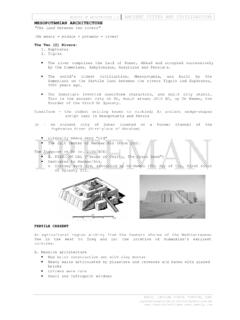Transcription of KINGDOMS, KINGS AND AN EARLY REPUBLIC
1 54 OUR PASTS IElection dayShankaran woke up to see his grandparents all ready togo and vote. They wanted to be the first to reach thepolling booth. Why, Shankaran wanted to know, werethey so excited? Somewhat impatiently, his grandfatherexplained: We can choose our own rulers today. How some men became rulersChoosing leaders or rulers by voting is somethingthat has become common during the last fiftyyears or so. How did men become rulers in thepast? Some of the rajas we read about in Chapter5 were probably chosen by the jana,the , around 3000 years ago, we find somechanges taking place in the ways in which rajaswere chosen. Some men now became recognisedasrajas by performing very big or horse sacrifice was onesuch ritual. A horse was let loose to wander freelyand it was guarded by the raja s men. If the horsewandered into the kingdoms of other rajas andthey stopped it, they had to fight.
2 If they allowedthe horse to pass, it meant that they acceptedthat the raja who wanted to perform the sacrificewas stronger than them. These rajas were theninvited to the sacrifice, which was performed byspecially trained priests, who were rewarded withgifts. The raja who organised the sacrifice wasrecognised as being very powerful, and all thosewho came brought gifts for was a central figure in these often had a special seat, a throne or a tigerskin. His charioteer, who was his companion inthe battle field and witnessed his exploits,CHAPTER 6 KINGDOMS, KINGS AND AN EARLY REPUBLIC NCERTnot to be republished55 chanted tales of his glory. His relatives, especiallyhis wives and sons, had to perform a variety ofminor rituals. The other rajas were simplyspectators who had to sit and watch theperformance of the sacrifice.
3 Priests performedthe rituals including the sprinkling of sacred wateron the king . The ordinary people, the vish orvaishya, also brought gifts. However, some people,such as those who were regarded as shudras bythe priests, were excluded from many a list of all those who would be presentat the sacrifice. Which are the categories that aredescribed in terms of their occupation? KINGDOMS, KINGS ANDAN EARLY REPUBLICV arnasWe have many books that were composed in north India, especially inthe areas drained by the Ganga and the Yamuna, during this books are often called later Vedic, because they were composedafter the Rigveda about which you learnt in Chapter 5. These includethe Samaveda, Yajurveda and Atharvaveda, as well as other were composed by priests, and described how rituals were to beperformed. They also contained rules about were several different groups in society at this time priestsand warriors, farmers, herders, traders, crafts persons, labourers, fishingfolk, and forest people.
4 Some priests and warriors were rich, as weresome farmers and traders. Others, including many herders, craftspersons, labourers, fishing folk and hunters and gatherers, were priests divided people into four groups, called varnas. Accordingto them, each varna had a different set of first varna was that of the were expected tostudy (and teach) the Vedas, perform sacrifices and receive the second place were the rulers, also known as kshatriyas. Theywere expected to fight battles and protect were the vish or the vaishyas. They were expected to be farmers,herders, and traders. Both the kshatriyas and the vaishyas couldperform sacrifices. NCERTnot to be republished 56 OUR PASTS IPainted Grey and bowls are themost common vesselsmade out of PaintedGrey Ware. These areextremely fine to touch,with a nice, smoothsurface. Perhaps thesewere used on specialoccasions, for importantpeople, and to servespecial who performed these big sacrifices werenow recognised as being rajas of janapadas ratherthanjanas.
5 The word janapada literally meansthe land where the jana set its foot, and settleddown. Some important janapadas are shown onMap 4 (page 57).Archaeologists have excavated a number ofsettlements in these janapadas, such as PuranaQila in Delhi, Hastinapur near Meerut, andAtranjikhera, near Etah (the last two are inUttar Pradesh). They found that people livedin huts, and kept cattle as well as otheranimals. They also grew a variety of crops rice, wheat, barley, pulses, sugarcane,sesame and there a crop in this list that was notmentioned in Chapter 4?Last were the shudras, who had to serve the other three groups andcould not perform any rituals. Often, women were also grouped with theshudras. Both women and shudras were not allowed to study the priests also said that these groups were decided on the basis ofbirth.
6 For example, if one s father and mother were brahmins one wouldautomatically become a brahmin, and so on. Later, they classified somepeople as untouchable. These included some crafts persons, huntersand gatherers, as well as people who helped perform burials andcremations. The priests said that contact with these groups was people did not accept the system of varna laid down by thebrahmins. Some KINGS thought they were superior to the priests. Othersfelt that birth could not be a basis for deciding which varna peoplebelonged to. Besides, some people felt that there should be no differencesamongst people based on occupation. Others felt that everybody shouldbe able to perform rituals. And others condemned the practice ofuntouchability. Also, there were many areas in the subcontinent, suchas the north-east, where social and economic differences were not verysharp, and where the influence of the priests was did people oppose the system of varnas?
7 NCERTnot to be republished57 They made earthen pots. Some of these weregrey in colour, others were red. One special typeof pottery found at these sites is known as PaintedGrey Ware. As is obvious from the name, thesegrey pots had painted designs, usually simplelines and geometric 2500 years ago, some janapadas becamemore important than others, and were known of these are shown on Map4. Most mahajanapadas had a capital city, manyof these were fortified. This means that huge wallsof wood, brick or stone were built around : 4 Important Janapadas,Mahajanapadas and Cities57 KINGDOMS, KINGS ANDAN EARLY REPUBLIC NCERTnot to be republished 58 OUR PASTS IForts were probably built because people wereafraid of attacks from other KINGS and neededprotection. It is also likely that some rulers wantedto show how rich and powerful they were bybuilding really large, tall and impressive wallsaround their cities.
8 Also in this way, the land andthe people living inside the fortified area could becontrolled more easily by the king . Building suchhuge walls required a great deal of , if not lakhs of bricks or stone had tobe prepared. This in turn meant enormous labour,provided, possibly, by thousands of men, womenand children. And resources had to be found forall of fortification wall is a picture ofremains of a wall made ofbrick, found nearpresent-day Allahabad(Uttar Pradesh). A partof it was probably builtabout 2500 years ago. NCERTnot to be republished59 The new rajasnow began maintaining were paid regular salaries and maintainedby the king throughout the year. Some paymentswere probably made using punch marked coins(see the illustration on page 92). You will readmore about these coins in Chapter two ways in which the rajas of themahajanapadas were different from thosementioned in the xe sAs the rulers of the mahajanapadas were(a) building huge forts (b) maintaining big armies,they needed more resources.
9 And they neededofficials to collect these. So, instead of dependingon occasional gifts brought by people, as in thecase of the raja of the janapadas, they startedcollecting regular taxes. Taxes on crops were the most important. This wasbecause most people were farmers. Usually, the taxwas fixed at 1/6th of what was produced. This wasknown as bhaga or a share. There were taxes on crafts persons as well. Thesecould have been in the form of labour. For example,a weaver or a smith may have had to work for a dayevery month for the king . Herders were also expected to pay taxes in the formof animals and animal produce. There were also taxes on goods that were boughtand sold, through trade. And hunters and gatherers also had to provideforest produce to the do you think would have been providedby hunters and gatherers? KINGDOMS, KINGS ANDAN EARLY REPUBLIC NCERTnot to be republished 60 OUR PASTS IChanges in agricultureThere were two major changes in agriculturearound this time.
10 One was the growing use ofiron ploughshares. This meant that heavy, clayeysoil could be turned over better than with awooden ploughshare, so that more grain couldbe produced. Second, people began transplantingpaddy. This meant that instead of scattering seedon the ground, from which plants would sprout,saplings were grown and then planted in thefields. This led to increased production, as manymore plants survived. However, it was backbreaking work. Generally, slave men and women,(dasasanddasis) and landless agriculturallabourers (kammakaras) had to do this you think why KINGS would encouragethese changes?A closer look (a) MagadhaFind Magadha on Map 4 (page 57). Magadhabecame the most important mahajanapada inabout two hundred years. Many rivers such asthe Ganga and Son flowed through Magadha. Thiswas important for (a) transport, (b) water supplies(c) making the land fertile.












